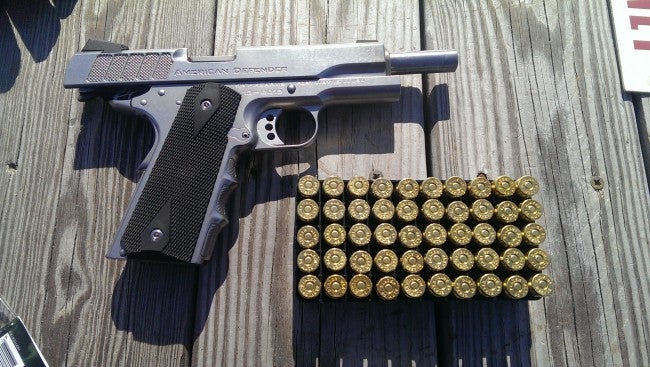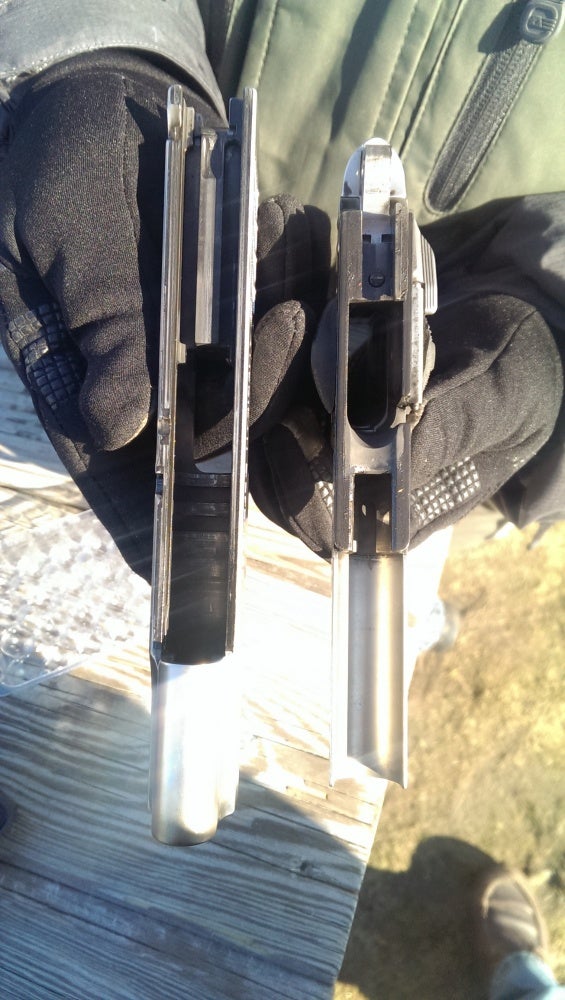Schroeder Bauman impressed me after my factory tour. Their knowledge, service, and dedication to craft was laudable. Now with a pistol in hand and plenty of ammo, I headed out to the range. Was the American Defender good enough to turn a proclaimed “not-1911” guy into a fan?
Overview:
Schroeder Bauman started as a subsidiary of SWS Trimac, an acclaimed materials science, tooling, and manufacturing firm. Drawing on a lifetime of welding and forming the world’s hardest materials, Owner and President Jar Morley sold SWS and embarked on something he really wanted to do: make quality pistols. He turned his attention and considerable expertise to hone the iconic Model 1911.
Not content to be just another “me too” custom 1911 shop, Schroeder Bauman has added four features that stand-out over a standard series 70.
- The pistols, outside of the trigger, barrel (Storm Lake), grips, and sights are entirely machined in-house. SB controls tolerances throughout the entire process.
- Second, the pistols have optional finger grooves machined into the frame.
- Third, SB’s proprietary “diamond back” slide checkering for extreme grip.
- Finally and most interestingly, an infused ceramic coating on the slide and frame rails for increase lubricity.
Handing & Range Testing:
SB provided me serial number 13-0013, an American Defender full-sized 1911 with diamond back slide checkering and a finger grooved frame. SB estimates that the pistol has seen 6,000+ rounds prior to my review with no spring or component changes. Stock sights were the venerable Novak three-dot (tritium sights are optional). SB uses a standard-length guide rod, and the pistol had SB’s new extended thumb safety. The hammers are a nifty EDM-cut “x” pattern and the pistol came with the original rubber grips; carbon fiber grips are also available. The pistol as configured would retail for a suggested $2,539.
As would be expected at this price range, fit and finish was excellent. No discernible wobble between the slide and frame, yet no issues racking the slide. The thumb safety gave an affirmative click into both positions and the slide stop grabbed the slide every time with an empty magazine.
I particularly enjoyed the grooved frame and diamond back slide. With my medium sized (sized 10) hands, my fingers naturally found the grooves and the checkering on the front and back-strap was grippy without being too rough. We attempted to take the pistol from the hand (after chamber-checking and flagging). The finger grooves made it significantly more difficult to steal the pistol from the shooter, the grooves giving the fingers extra leverage to stop rotation and resist pulling. The slide checkering made it easy to index and rack the slide, especially when used bare-handed. On a personal note, I wish SB offered the same checkering on the front of the slide standard.
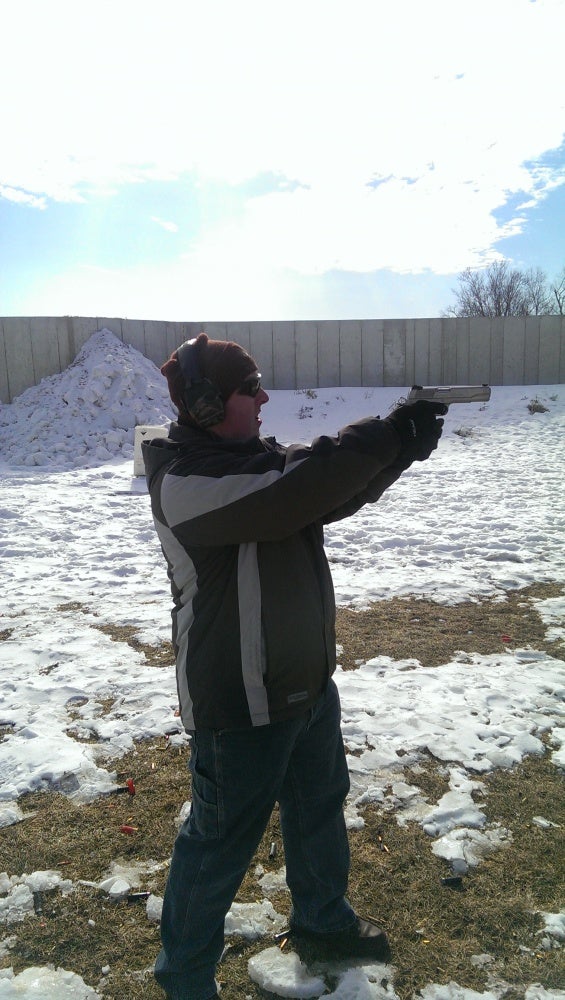
Tim B., my token “new gun guy” that I take with me on reviews. Tim has a Master’s in Mechanical Engineering; he provides valuable insight into designs and a influence-free perspective. We do need to work on his posture.
For testing, I had 200 rounds of Blazer Brass and 40 hollow-points. SB graciously provided the box of Hornady 185-grain Critical Defender (FTX bullet) and a box of the new Dynamic Research Technologies 150-grain solid jacket, frangible core rounds. The pistol came equipped with 3 Chip McCormick 8-round Power Mags, 2 brand new and 1 well-used. New pistols will come with 2 magazines.
Prior to the range, the pistol was subjected to a thorough field-strip cleaning to remove any outside variables. Using Break-Free CLP, elbow grease, and plenty of weapons cleaning pads, the pistol was cleaned to shine and white cloths. During this process, the ceramic infusion was noticeable. The material used in the process leaves black coloration which looks like residue. Despite the aesthetic trickery, the areas were all completely smooth.
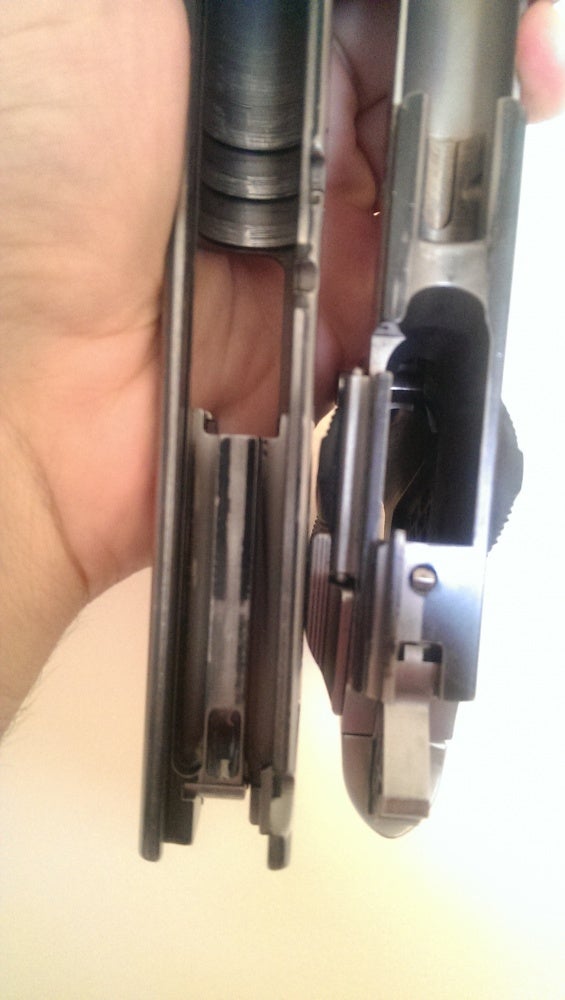
The SB American Defender 1911 completely clean. Note the ceramic infusion material left behind in the process. It may look dirty, but it is completely smooth.
Against SB’s recommendations, I immediately shot 100 rounds of the Blazer Brass on the pistol, bone-dry with no issues. I will say that again: a stainless steel 1911 was run bone-dry with no issues. After the first 100 rounds, the pistol was disassembled and lubricated using Break-Free CLP.
Recoil was pleasant and felt most like a polite shove versus the snappy .40 Glock 23 we had for comparison testing.. The video below shows myself running it during the “dry-fire” phase.
*Note: I DID flinch before the third magazine. I caught myself and called it out, but feel free to castigate me in the comments.
Accuracy was excellent. Using only a Caldwell rice-filled shooting rest, the SB 1911 was shooting ~1.5″ groups at 25 yards. The trigger helped immensely. It felt like a high-end two-stage AR trigger, but with a straight pull. The SB trigger had about 2mm of take-up prior to a firm hold-up and and solid break. My Lyman digital trigger gauge measured the take-up at 1.5 lbs and the final break at an average of 4 lbs, 1 oz. It was exceptionally easy to run the gun hard and fast, but with only 8+1 rounds it was over too quick.
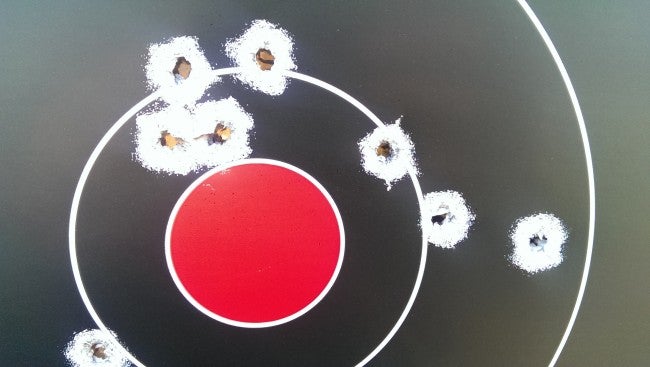
My four-shoot group is in the upper left. The other four on the right and bottom left are Tim’s. The fully-adjustable sights arrived about 6 inches low at 25 yards, but were easy to get on target after a about 10 rounds and a flat-head head screw-driver.
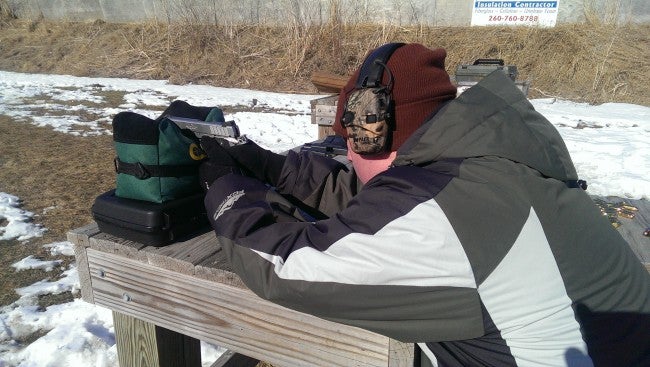
Tim shooting for accuracy on the Caldwell rest. The crisp trigger made it easy to break good shots, but Tim was jerking the trigger. We blame the gloves needed to keep warm handing a metal-framed gun.
The hollow-points were shot last and worked flawlessly when loaded with with like ammunition. There was no noticeable point of impact shift between the three types of rounds present, although the Critical Defense was noticeably snappier like the .40 and the DRT felt softer than plinking 9mm out of a Beretta.
The oldest of the three magazines did caused two separate failures to feed. The first malfunction was about 150 rounds into the Blazer Brass, we experienced a “high angle” malfunction on the last round from the oldest of the magazines, which is indicative of the spring not pushing fast enough.
To push the pistol to the limit, the last four rounds of each box were loaded every-other between the 185-grain Hornady and 150-grain DRT in the worst magazine. Like the first malfunction, the last round of DRT failed to feed, this time a feed-way stoppage. The rim of the case caught on the feed-ramp. A simple tap-rack-bang fixed the problem. I hold this in now way against the SB.
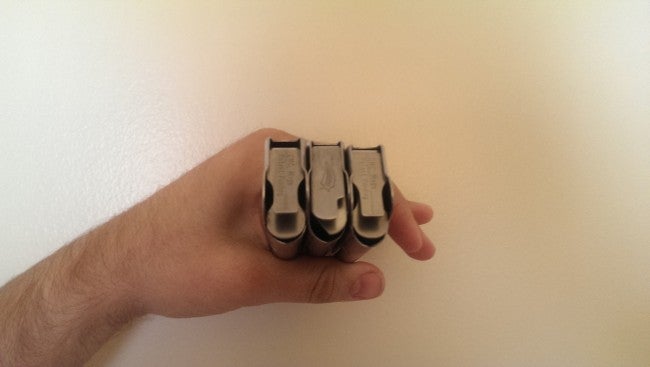
- The three magazines I had for testing. Note the middle magazine (the oldest one) has a different follower geometry. Combined with its round-count, the magazine caused two failures to feed.
When I got home for the post-shoot cleaning, I disassembled the magazines for a comparison. The oldest magazine was dirty and and had a different follower geometry.
The pistol itself was pleasant to clean. Unlike some phosphate or other finishes, the stainless was almost effortless to wipe clean. I needed no or very little CLP to get all the gunpowder residue. From a dirty gun to (my meticulous standards) clean one only took a 1/2 hour, including a break to walk the dog.
Conclusion
As Tim put it after we were done shooting. “I would buy the Glock first, but I would get this pistol as a if I had the money and the Glock; In the same way I would buy a truck prior to getting a supercar.”
Tim’s comment was not a discount to the pistol. If anything, it is a compliment. To continue the metaphor: the SB 1911 is the Audi R8 of the handgun world. It is for those who are looking for a “value-oriented” super-car. Significantly less expensive than other models, yet not sacrificing on quality and completely satisfying while being absolutely gorgeous.
So, did the pistol convert me to the virtues of the 1911? Not yet. I prefer ARs and modern semi autos to a Garand. That said, preferring another platform does not preclude me from appreciating another. I may not (yet) be a 1911 guy, but I walk away a Schroeder Bauman guy. As ThomasD so eloquently wrote is his earlier comment on the factory tour:
But beyond the marketing techno-sizzle, when I meet or hear about a new craftsman or manufacturer all I need to know is that they love what they make, and they love making it well.
I hope they succeed.
Me too.
The SB American Defender is a fine pistol. Its the product of true craftsman from the best city I know. For those looking for high quality, innovative features, and the option for complete customization, Schroeder Bauman is an excellent choice.
 Your Privacy Choices
Your Privacy Choices

